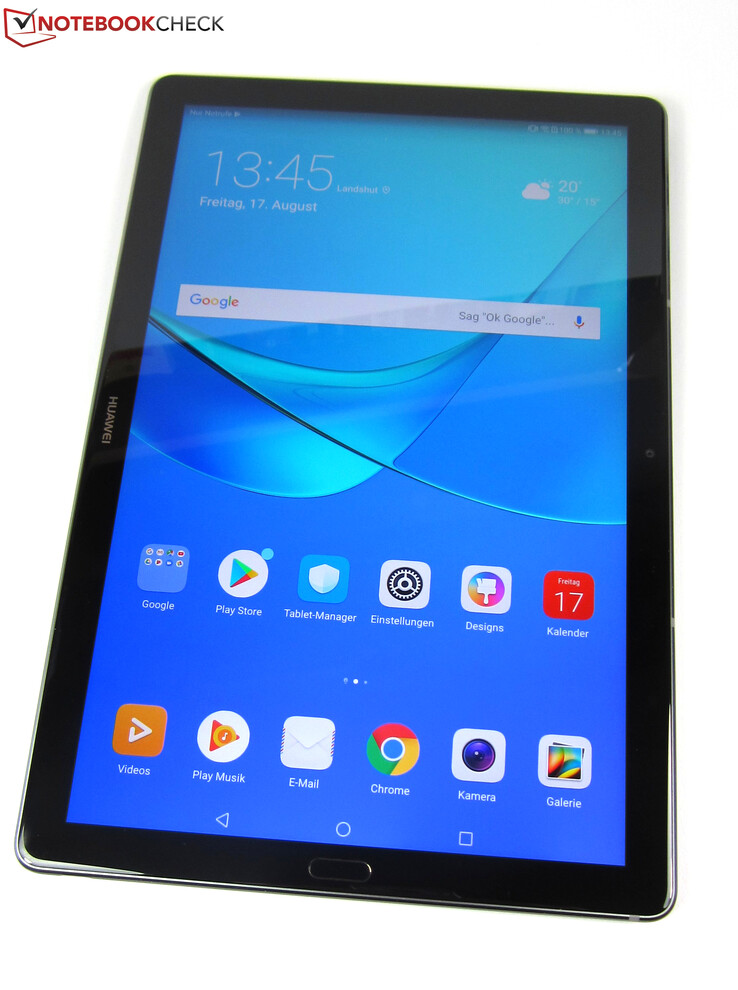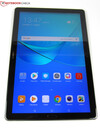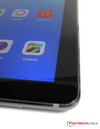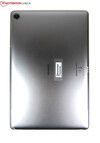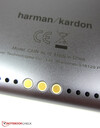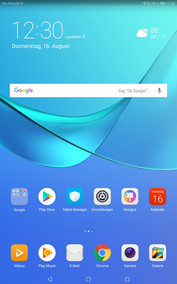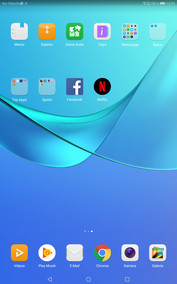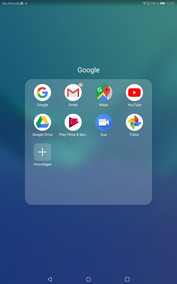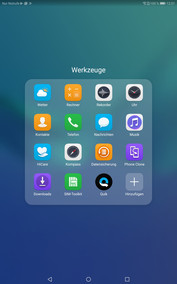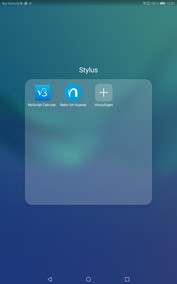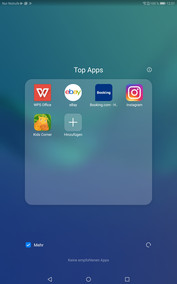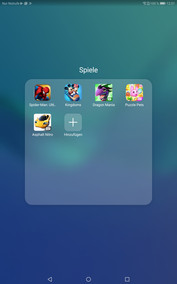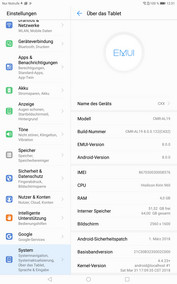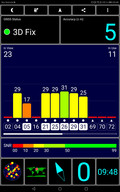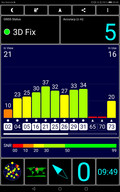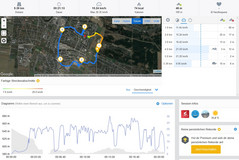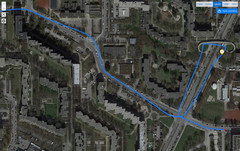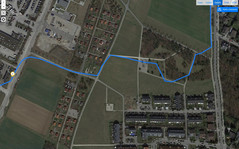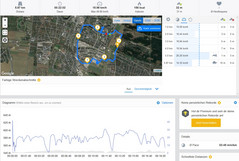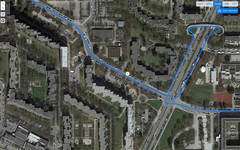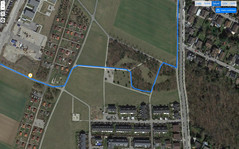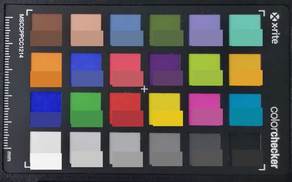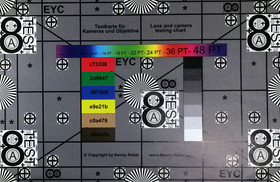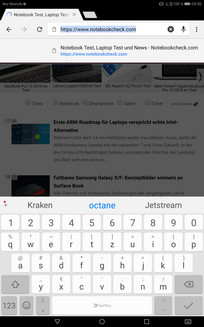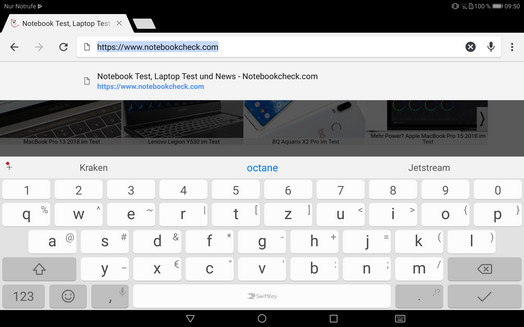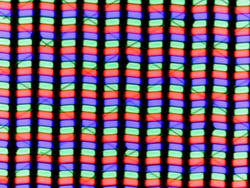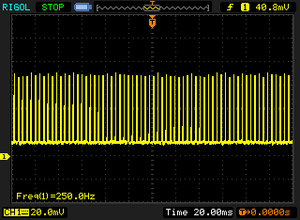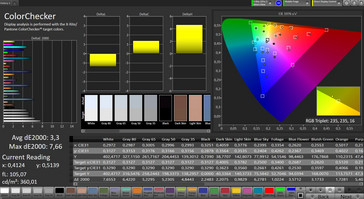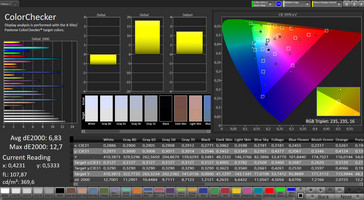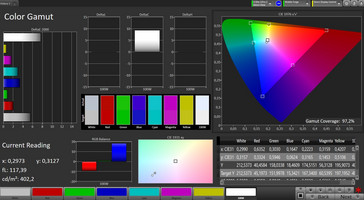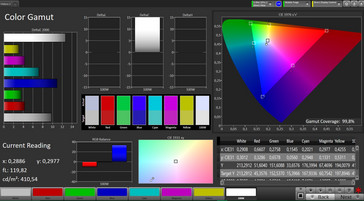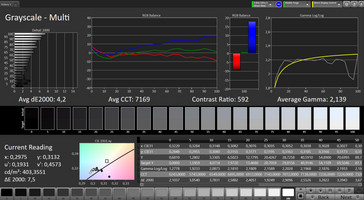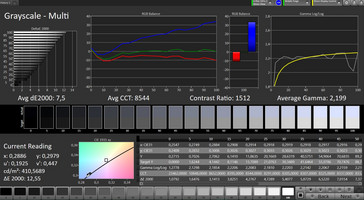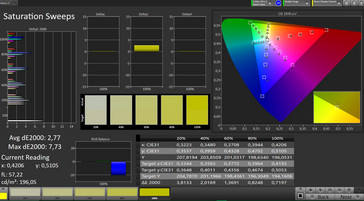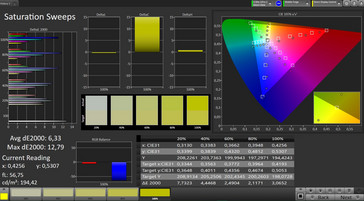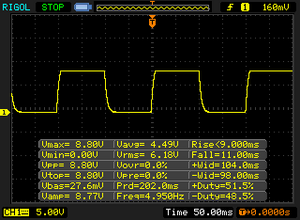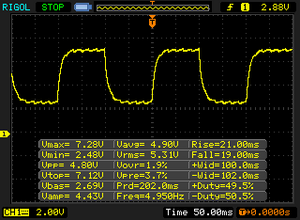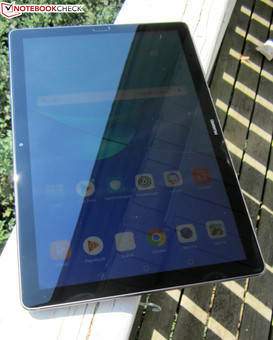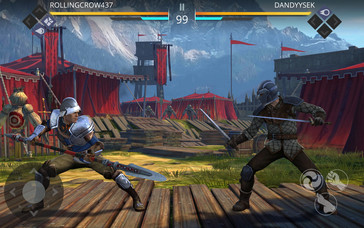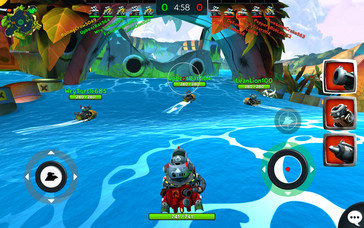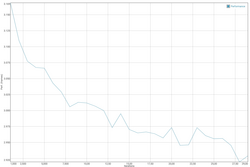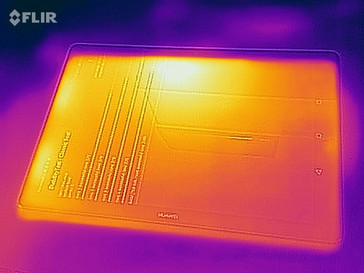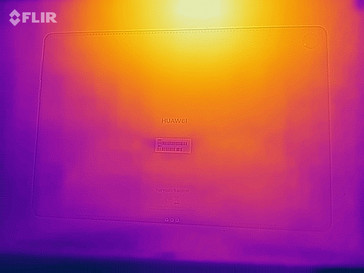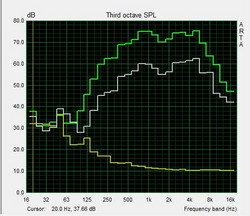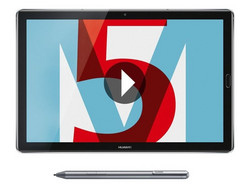Huawei MediaPad M5 10.8 Pro Tablet Review

Huawei also offers an enhanced version of its high-end tablet MediaPad M5 10.8. It is called MediaPad M5 10.8 Pro and has 3 additional features over the standard MediaPad.
Unlike the MediaPad M5 10.8, Huawei foregoes a pure Wi-Fi and a 32 GB version. Instead, the Pro version always comes with 64 GB storage space and an LTE module. Secondly, the test device is powered by the more powerful HiSilicon Kirin 960 instead of the MediaPad M5 10.8's octa-core SoC HiSilicon Kirin 960s. Finally, the Mate Pen 2, a digital stylus for writing and sketching, is always included with the MediaPad M5 10.8 Pro.
Although the MediaPad M5 10.8 is not exactly a bargain in its maximum configuration already (officially 449 Euros or ~$521.99), Huawei charges even more for the MediaPad M5 10.8 Pro (549 Euros or ~$472.23). In this review we determine whether it is worth it to pay a premium for the short list of additional features. We put the Huawei tablet up against the MediaPad M5 10.8 and the similarly equipped Acer Iconia Tab 10 (A3-A50), the Apple iPad 6 (2018), the Lenovo Tab 4 10 Plus and the Amazon Fire HD 10 (2017).
Case - Identical to the MediaPad M5 10.8
When putting the Huawei MediaPad M5 10.8 Pro down next to the Huawei MediaPad M5 10.8, the tablets look identical. The Pro version, too, combines a chic metal back cover with a rounded-off 2.5D glass front with an aspect ratio of 16:10. This amounts to a tablet with a thickness of 7.3 millimeters (~0.3 in) that weighs 498 grams (~1.1 lb) and has a good feel to it as well as good handling. It also does not have any clearance worth mentioning and comes across as a very high-quality device.
Huawei has placed the finger print sensor on the front to the right of the display. The 13 MP camera is placed on the back to the left and protrudes a few millimeters from the chassis. The subtle curvature of the back cover balances this out, ensuring the tablet does not wobble around when placed on a desk. Huawei currently only offers the color option "Space Gray" for the MediaPad M5 10.8 Pro.
Connectivity - 64 GB eMMC by Default
The Huawei MediaPad M5 10.8 Pro has 64 GB of storage space, which can be expanded by up to 256 GB through the microSD card slot. However, we were unable to transfer app data to the removable media. The microSD slot and the nano SIM card share the tray on the right side.
At first glance, the Huawei tablet appears to offer only one physical port: The USB type-C port, which supports USB 3.0 speeds but manages to transfer data at only USB 2.0 speeds - it also supports USB-OTG.
At the same time however, the USB type-C port serves as a replacement for the unavailable 3.5 mm audio jack. To this end, a suitable USB type-C adapter has been included. The third and most subtle physical port sits on the bottom: A row of three pogo pins that can be used to connect a keyboard. At the time of testing, Huawei does not offer a fitting keyboard on their web site. However, compatible products can easily be found via a quick search containing "Huawei", "M5" and "keyboard".
Software - Android 8.0, EMUI and a lot of Apps
Huawei has installed the up-to-date Android 8.0 Oreo on their MediaPad M5 10.8 Pro and complements it with their popular EMUI overlay, which comes in version 8.0 as well. The ROM takes up a lot of space overall, since only 51.5 GB of the nominal 64 GB of storage space is available ex-factory. This not only stems from the Huawei UI, but also from the many preinstalled apps.
The app assortment consists of helpful applications such as the migration tool Phone CLone and the manufacturer's own HiCare service tool as well as a small selection of free2play games and also straight-up advertisement apps. Conveniently however, every app can be uninstalled. However, it is a good idea to leave the stylus folder untouched at first, since with "MyScript Calculator" (calculator) and "Nebo" (notes app), it contains two apps specifically tailored to the included digital stylus Mate Pen 2.
At the time of testing (mid August), the Android security patches dated back to May 1st 2018, and were thus outdated. Shortly after however, an update to the security patch layer from June 1st 2018 was released, fixing this minor shortcoming.
Communication and GPS - Relatively fast Wi-Fi, precise GPS
Aside from GSM and UMTS, the MediaPad M5 10.8 Pro also supports LTE Cat. 6. In conjunction with a nano SIM card as well as a suitable mobile data plan, it allows for downloads at up to 300 Mbit/s and uploads at up to 50 Mbit/s. With an appropriate cell phone plan, calls can also be made with the tablet. In our test, the reception in the local Vodafone mobile data network was good.
For short distances, the tablet uses Bluetooth 4.2 and Wi-Fi 802.11a/b/g/n/ac, which means that it supports the 2.4 GHz and the 5.0 GHz frequency bands. Paired with our reference router Linksys EA8500, the MediaPad M5 10.8 Pro receives data at up to 238 Mbit/s through Wi-Fi, making it only marginally slower on the go at 236 Mbit/s. With this result, the test candidate is able to barely beat its in-house competition Huawei MediaPad M5 10.8, whereas it is not even half as fast as the Apple iPad 6 (2018). However, aside from the Lenovo Tab 4 10 Plus, the other devices in the comparison are far from the top values of the Apple tablet as well.
The MediaPad M5 10.8 Pro uses GPS, A-GPS and GLONASS to determine its current location, which, in our test, it did fairly quickly outdoors and inside of buildings with an accuracy of within 5 meters (~16 ft). This result contrasts that of the Huawei MediaPad M5 10.8: Here, locating inside of buildings did not work at all and outside it only did after a significant delay and with little precision. For the sake of fairness, it should be noted that the GPS test were performed at two different locations and that the MediaPad M5 10.8 Pro had an easier "indoors" test (wooden frames instead of reinforced concrete).
As usual, we determined the day-to-day accuracy of the test candidate's GPS module with a short bike ride, on which we also took the professional navigation system Garmin Edge 520. While the Huawei tablet is not able to match the Garmin device's accuracy, it never deviates far from the actual route in terms of locating. All in all, its navigation features are more than suited for day-to-day app use.
Cameras - Good for a Tablet
The MediaPad M5 10.8 Pro shares its camera features with the MediaPad M5 10.8. On the back, there is a 13 megapixel main camera which captures photos with a maximum resolution of up to 4160x3120 pixels, has an aperture of f/2.2, uses autofocus and even supports the RAW format when using the Pro mode. In addition, there is a 8 megapixel camera on the front which also has an f/2.2 aperture and features fixed-focus lens. It is more than suitable as a webcam replacement.
The MediaPad M5 10.8 Pro clearly gets the short end of the stick against a high-quality smartphone camera such as the Apple iPhone X' or the OnePlus 5T', but it lends itself well for the occasional snapshot here and there.
Under good lighting conditions, the 13 MP camera manages to take decent pictures which still capture fine details relatively accurately and have good color representation. Due to the lack of a flash, low-light pictures have a lot of noise and are little more than a makeshift when there is no other camera within reach. The Huawei tablet records videos at a maximum resolution of 3840x2176 pixels (4K) and at 30 FPS, that also have a lot of noise in them under poor lighting conditions.
Under controlled lighting conditions, it becomes apparent that the 13 MP camera captures the ColorChecker color card relatively true to original, although colors tend to be somewhat oversaturated. Grayscales are the other way around and always appear a shade too dark. The test chart presents a big challenge for the tablet: While the image sharpness is still okay, small details such as color gradients, transitions or patterns are lost in the image noise.
Accessories and Warranty - Digital Stylus for the Pro Version
Huawei includes the digital stylus Mate Pen 2, a modular charger (9 V/2 A), a USB cable (type-C to type-A), an audio adapter (type-C to 3.5 mm jack) as well as a SIM tool with the MediaPad M5 10.8 Pro. Huawei does not offer accessories specific to their tablet on their web page.
The MediaPad M5 10.8 Pro comes with a 24-month warranty. Please see our Guarantees, Return policies and Warranties FAQ for country-specific information.
Input Devices & Handling - Mate Pen 2 as an Additional Input Method
The Huawei MediaPad M5 10.8 Pro handles inputs smoothly and without delays in the test. The tablet reacts equally well to commands given by the finger using the touchscreen or the reliable fingerprint sensor and the Mate Pen 2, which only requires a small amount of pressure on the display for a feedback.
Huawei has preinstalled the apps "MyScript Calculator" (calculator) and "Nebo" (notes app) for the digital stylus. The calculator produces results for handwritten inputs such as "5+3=" and the notes app offers smart extras, for example text recognition or text deletion by striking something through.
All physical control elements (fingerprint sensor, power button, volume control) have been placed on the right side of the tablet. The first of the three can adopt the functions of the pictured Android buttons and is thus able to serve as an external navigation row. The NaviDot, a button that can be placed anywhere on the display and is also suited for navigating the system, takes on a similar role.
If the tablet is placed on an even surface, the power button and the volume control can barely be reached at best due to the curvature of the chassis, which, depending on the situation can be anything from practical to annoying. If the navigation feature of the finger print sensor has been activated, one must take care not to touch it while holding the tablet in landscape mode.
Display - 2K Resolution, Low Luminance, PWM Flickering
The Huawei MediaPad M5 10.8 Pro shows its "2K" resolution of 2560x1600 pixels on its 10.8-inch IPS display and, with 280 PPI, achieves a very sharp representation. At 360 cd/m² on average, it has a luminance which is almost identical to the MediaPad M5 10.8's, while not shining as bright in comparison. This also applies, when repeating the brightness meterings with a, due to being more even, more realistic distribution of bright and dark display areas (APL50). Then, up to 365 cd/m² are possible. Without the brightness sensor being active, the luminance climbs up to 387 cd/m².
The remaining image parameters do not exactly impress either, illumination, for example, is below average at 84 percent. The black value of 0.8 and the contrast ratio of just 480:1 are not good results either. The subjective impression is much better however: The display does not appear pale at all, but rather lifelike and natural.
| |||||||||||||||||||||||||
Brightness Distribution: 84 %
Center on Battery: 384 cd/m²
Contrast: 480:1 (Black: 0.8 cd/m²)
ΔE ColorChecker Calman: 6.83 | ∀{0.5-29.43 Ø4.78}
ΔE Greyscale Calman: 7.5 | ∀{0.09-98 Ø5}
99.8% sRGB (Calman 2D)
Gamma: 2.199
CCT: 8544 K
| Huawei MediaPad M5 10.8 Pro IPS, 2560x1600, 10.8" | Acer Iconia Tab 10 A3-A50 IPS, 1920x1200, 10.1" | Apple iPad 6 2018 IPS, 2048x1536, 9.7" | Lenovo Tab 4 10 Plus IPS, 1920x1200, 10.1" | Amazon Fire HD 10 2017 IPS, 1920x1200, 10.1" | Huawei MediaPad M5 10.8 IPS, 2560x1600, 10.8" | |
|---|---|---|---|---|---|---|
| Screen | 22% | 55% | 52% | 40% | 60% | |
| Brightness middle (cd/m²) | 384 | 340 -11% | 530 38% | 443 15% | 426 11% | 382 -1% |
| Brightness (cd/m²) | 360 | 320 -11% | 513 43% | 428 19% | 399 11% | 378 5% |
| Brightness Distribution (%) | 84 | 84 0% | 92 10% | 94 12% | 91 8% | 92 10% |
| Black Level * (cd/m²) | 0.8 | 0.19 76% | 0.61 24% | 0.36 55% | 0.38 52% | 0.24 70% |
| Contrast (:1) | 480 | 1789 273% | 869 81% | 1231 156% | 1121 134% | 1592 232% |
| Colorchecker dE 2000 * | 6.83 | 15 -120% | 1.2 82% | 3.3 52% | 4.5 34% | 2.8 59% |
| Colorchecker dE 2000 max. * | 12.7 | 22.8 -80% | 3.2 75% | 7.2 43% | 7.9 38% | 6 53% |
| Greyscale dE 2000 * | 7.5 | 4 47% | 1 87% | 2.9 61% | 5.2 31% | 3.5 53% |
| Gamma | 2.199 100% | 2.09 105% | 2.28 96% | 2.27 97% | 2.23 99% | 2.33 94% |
| CCT | 8544 76% | 6940 94% | 6588 99% | 6961 93% | 6875 95% | 6903 94% |
* ... smaller is better
Screen Flickering / PWM (Pulse-Width Modulation)
| Screen flickering / PWM detected | 250 Hz | ≤ 15 % brightness setting | |
The display backlight flickers at 250 Hz (worst case, e.g., utilizing PWM) Flickering detected at a brightness setting of 15 % and below. There should be no flickering or PWM above this brightness setting. The frequency of 250 Hz is relatively low, so sensitive users will likely notice flickering and experience eyestrain at the stated brightness setting and below. In comparison: 53 % of all tested devices do not use PWM to dim the display. If PWM was detected, an average of 8118 (minimum: 5 - maximum: 343500) Hz was measured. | |||
The display of the MediaPad M5 10.8 Pro unfortunately uses PWM at a very low frequency of 250 Hz, which can cause eye strain for sensitive people. This only comes into effect at display brightness levels equal to or below 15 percent, which due to the small luminance reserves of the tablet should not be common in practice.
When taking a closer look at the display with a spectrophotometer and the CalMAN software, it shows its relatively accurate color representation properties, although it exhibited a slight blue tint as well as a slightly elevated color temperature in every mode we tested. Screen content representation can be adjusted in the tablet's display settings. The color modes are "normal" and "vivid", whereas the color temperature can be freely set or one of the presets "standard", "warm" or "cold" can be selected.
Display Response Times
| ↔ Response Time Black to White | ||
|---|---|---|
| 20 ms ... rise ↗ and fall ↘ combined | ↗ 9 ms rise | |
| ↘ 11 ms fall | ||
| The screen shows good response rates in our tests, but may be too slow for competitive gamers. In comparison, all tested devices range from 0.1 (minimum) to 240 (maximum) ms. » 42 % of all devices are better. This means that the measured response time is similar to the average of all tested devices (20.2 ms). | ||
| ↔ Response Time 50% Grey to 80% Grey | ||
| 40 ms ... rise ↗ and fall ↘ combined | ↗ 21 ms rise | |
| ↘ 19 ms fall | ||
| The screen shows slow response rates in our tests and will be unsatisfactory for gamers. In comparison, all tested devices range from 0.165 (minimum) to 636 (maximum) ms. » 60 % of all devices are better. This means that the measured response time is worse than the average of all tested devices (31.6 ms). | ||
Since the MediaPad M5 10.8 Pro offers little in terms of luminance reserves, turning up the screen brightness all the way is recommended for outdoor use. On top of that, we deactivated the brightness sensor since it always turned down brightness by a tiny bit too much. The Huawei tablet can be used well outdoors, provided you can find a place in the shade. Hereby, it benefits from its good viewing angles. Screen contents can be made out even at extreme side angles and at worst appear slightly darker, but never color distorted or even inverted.
Performance - Worthy Competitor to the Apple iPad 6
With the MediaPad M5 10.8 Pro, Huawei relies on their in-house-produced SoC HiSilicon Kirin 960. Compared to the MediaPad M5 10.8's HiSilicon Kirin 960s, it does not have an NPU for AI acceleration, but at 2.400 instead of 2.100 MHz its core clock is higher, which also becomes apparent in the benchmarks.
In the synthetic benchmarks, the MediaPad M5 10.8 Pro almost always comes out ahead of the MediaPad M5 10.8. The Huawei internal duel only comes close to a draw in 3DMark and GFXBench. The MediaPad M5 10.8 has a particularly large lead in the AnTuTu v7 benchmark, where it even barely surpasses the Apple iPad 6 (2018), which is overall the fastest at completing the synthetic benchmark course. The Huawei test candidate crosses the finish line not far behind it however.
| AnTuTu v6 - Total Score | |
| Huawei MediaPad M5 10.8 Pro | |
| Huawei MediaPad M5 10.8 | |
| Average HiSilicon Kirin 960 (124087 - 157445, n=7) | |
| Acer Iconia Tab 10 A3-A50 | |
| Amazon Fire HD 10 2017 | |
| Lenovo Tab 4 10 Plus | |
| AnTuTu v7 - Total Score | |
| Huawei MediaPad M5 10.8 Pro | |
| Average HiSilicon Kirin 960 (170015 - 181614, n=4) | |
| Apple iPad 6 2018 | |
| Huawei MediaPad M5 10.8 | |
| Amazon Fire HD 10 2017 | |
No other tablet gets close to the Apple iPad 6 (2018) in terms of browser performance. Although here the MediaPad M5 10.8 Pro is the most tenacious pursuer of the Apple high-flyer, which nets it second place again. Surfing the web feels fast subjectively. Only more demanding HTML5 web pages such as the flipper game “Ouigo Let's Play” require some waiting time, whereafter you are rewarded with a very smooth experience.
| Octane V2 - Total Score | |
| Average of class Tablet (763 - 138481, n=96, last 2 years) | |
| Apple iPad 6 2018 (Safari Mobile 11.3) | |
| Huawei MediaPad M5 10.8 Pro (Chrome 68.0.3440.91) | |
| Average HiSilicon Kirin 960 (10016 - 11897, n=7) | |
| Acer Iconia Tab 10 A3-A50 (Browser: Chrome Version 63) | |
| Amazon Fire HD 10 2017 (Amazon Silk 61.2) | |
| Huawei MediaPad M5 10.8 (Chrome 65) | |
| Lenovo Tab 4 10 Plus (Chrome 60) | |
| WebXPRT 2015 - Overall | |
| Apple iPad 6 2018 (Safari Mobile 11.3) | |
| Huawei MediaPad M5 10.8 Pro (Chrome 68.0.3440.91) | |
| Average HiSilicon Kirin 960 (107 - 184, n=7) | |
| Amazon Fire HD 10 2017 (Amazon Silk 61.2) | |
| Huawei MediaPad M5 10.8 (Chrome 65) | |
| Lenovo Tab 4 10 Plus (Chrome 60) | |
| JetStream 1.1 - Total Score | |
| Apple iPad 6 2018 (Safari Mobile 11.3) | |
| Average HiSilicon Kirin 960 (56.8 - 68.6, n=7) | |
| Huawei MediaPad M5 10.8 Pro (Chrome 68.0.3440.91) | |
| Acer Iconia Tab 10 A3-A50 (Browser: Chrome Version 63) | |
| Amazon Fire HD 10 2017 (Amazon Silk 61.2) | |
| Huawei MediaPad M5 10.8 (Chrome 65) | |
| Lenovo Tab 4 10 Plus (Chrome 60) | |
| Mozilla Kraken 1.1 - Total | |
| Lenovo Tab 4 10 Plus (Chrome 60) | |
| Huawei MediaPad M5 10.8 (Chrome 65) | |
| Amazon Fire HD 10 2017 (Amazon Silk 61.2) | |
| Acer Iconia Tab 10 A3-A50 (Browser: Chrome Version 63) | |
| Huawei MediaPad M5 10.8 Pro (Chrome 68.0.3440.91) | |
| Average HiSilicon Kirin 960 (2734 - 3734, n=7) | |
| Average of class Tablet (243 - 27101, n=81, last 2 years) | |
| Apple iPad 6 2018 (Safari Mobile 11.3) | |
* ... smaller is better
While the 64 GB of eMMC flash storage of the MediaPad M5 10.8 Pro makes for short loading times with its sequential read speed of 278.6 MB/s, it falls significantly behind the MediaPad M5 10.8 in 4 KB random reads. Still, its performance remains above the results of both the Acer Iconia Tab 10 (A3-A50) and the Amazon Fire HD 10 (2017).
The MediaPad M5 10.8 Pro is far from exhausting the capabilities of our reference microSD card Toshiba Exceria Pro M501 (read up to 270 Mbyte/s, write up to 150 Mbyte/s), but at 84.9 MB/s, it has above average sequential transfer speeds.
| Huawei MediaPad M5 10.8 Pro | Acer Iconia Tab 10 A3-A50 | Lenovo Tab 4 10 Plus | Amazon Fire HD 10 2017 | Huawei MediaPad M5 10.8 | Average 64 GB eMMC Flash | Average of class Tablet | |
|---|---|---|---|---|---|---|---|
| AndroBench 3-5 | -27% | 6% | -14% | 70% | 50% | 1090% | |
| Sequential Read 256KB (MB/s) | 278.6 | 173.7 -38% | 270.1 -3% | 262.2 -6% | 247.8 -11% | 277 ? -1% | 1786 ? 541% |
| Sequential Write 256KB (MB/s) | 94.1 | 92.4 -2% | 135.5 44% | 147.7 57% | 126.8 35% | 178.4 ? 90% | 1334 ? 1318% |
| Random Read 4KB (MB/s) | 27.41 | 13.7 -50% | 37.3 36% | 27.72 1% | 54.7 100% | 60.7 ? 121% | 244 ? 790% |
| Random Write 4KB (MB/s) | 15.35 | 8.77 -43% | 11.8 -23% | 9.37 -39% | 60.8 296% | 33.8 ? 120% | 278 ? 1711% |
| Sequential Read 256KB SDCard (MB/s) | 84.9 ? | 80.4 ? -5% | 83.9 -1% | 55.5 ? -35% | 85.1 ? 0% | 77.4 ? -9% | |
| Sequential Write 256KB SDCard (MB/s) | 73.1 ? | 56.8 ? -22% | 61.1 -16% | 30.14 ? -59% | 73.8 ? 1% | 58.3 ? -20% |
Gaming - A very Recommendable Tablet for Gamers
The Huawei MediaPad M5 10.8 Pro will serve you well if you are looking for a tablet suitable for gaming: During the test it not only managed to convince us with its position sensor and accelerometer, but also with its surround sound and its great SoC performance. Even maximum detail settings do not manage to bring the tablet below the 60 FPS mark in current games such as “Battle Bay” or “Shadow Fight 3”.
There is only one detail which does not seem quite right: When trying to play while charging the tablet, it is possible for the USB cable in the bottom right to be in the way, although this can be easily fixed by turning the MediaPad M5 10.8 Pro by 180 degrees.
| Shadow Fight 3 | |||
| Settings | Value | ||
| high | 60 fps | ||
| Battle Bay | |||
| Settings | Value | ||
| full resolution | 60 fps | ||
Emissions - Cool during Use, but with Frequent Throttling
Temperature
On the outside, the Huawei MediaPad M5 10.8 Pro has good thermals. Even after one hour under full load, the temperature indicator only rises to a very moderate 39.5 °C (~103.1 °F). As shown by the GFXBench battery tests however, the tablet internally reduces its clock speed in order to get heat dissipation under control.
Both in the less hardware intensive T-Rex benchmark as well as in the more demanding Manhattan scenario, each of which GFXBench runs 30 times, the performance drops after just a short amount of time. While the performance drops remain fairly minimal, it should be considered that the full power of the MediaPad 10.8 Pro cannot always be accessed.
(+) The maximum temperature on the upper side is 37.1 °C / 99 F, compared to the average of 33.7 °C / 93 F, ranging from 20.7 to 53.2 °C for the class Tablet.
(+) The bottom heats up to a maximum of 39.5 °C / 103 F, compared to the average of 33.2 °C / 92 F
(+) In idle usage, the average temperature for the upper side is 31.8 °C / 89 F, compared to the device average of 30 °C / 86 F.
Speakers
Huawei has installed four Harman Kardon speakers inside the case of the MediaPad M5 10.8 Pro, two of which are at the top and the other two at the bottom of the tablet. According to Huawei, the speakers are supposed to deliver powerful 3D sound, a promise which they actually keep. In the test, the speaker quartet of the MediaPad M5 10.8 Pro does a surprisingly good job of producing surround sound, which even has very balanced mids and highs. While the basses get somewhat lost in the overall sound pattern, playback is not distorted even at maximum volume.
When connecting a headset to the tablet using the included USB type-C adapter, the sound can be spiced up with Huawei Histen sound effects. Connecting via Bluetooth also works and produces high-quality sound thanks to aptX support.
Huawei MediaPad M5 10.8 Pro audio analysis
(+) | speakers can play relatively loud (84.6 dB)
Bass 100 - 315 Hz
(-) | nearly no bass - on average 73.6% lower than median
(+) | bass is linear (0% delta to prev. frequency)
Mids 400 - 2000 Hz
(-) | nearly no mids - on average 73.6% lower than median
(+) | mids are linear (0% delta to prev. frequency)
Highs 2 - 16 kHz
(-) | nearly no highs - on average 73.6% lower than median
(+) | highs are linear (0% delta to prev. frequency)
Overall 100 - 16.000 Hz
(-) | overall sound is not linear (110.3% difference to median)
Compared to same class
» 98% of all tested devices in this class were better, 1% similar, 1% worse
» The best had a delta of 7%, average was 20%, worst was 129%
Compared to all devices tested
» 96% of all tested devices were better, 0% similar, 4% worse
» The best had a delta of 4%, average was 24%, worst was 134%
Apple iPad 6 2018 audio analysis
(±) | speaker loudness is average but good (75.7 dB)
Bass 100 - 315 Hz
(±) | reduced bass - on average 11.2% lower than median
(±) | linearity of bass is average (11.9% delta to prev. frequency)
Mids 400 - 2000 Hz
(+) | balanced mids - only 1.3% away from median
(+) | mids are linear (5.9% delta to prev. frequency)
Highs 2 - 16 kHz
(+) | balanced highs - only 3.3% away from median
(±) | linearity of highs is average (11% delta to prev. frequency)
Overall 100 - 16.000 Hz
(+) | overall sound is linear (13.3% difference to median)
Compared to same class
» 25% of all tested devices in this class were better, 4% similar, 70% worse
» The best had a delta of 7%, average was 20%, worst was 129%
Compared to all devices tested
» 13% of all tested devices were better, 3% similar, 84% worse
» The best had a delta of 4%, average was 24%, worst was 134%
Huawei MediaPad M5 10.8 audio analysis
(±) | speaker loudness is average but good (79.9 dB)
Bass 100 - 315 Hz
(±) | reduced bass - on average 11.9% lower than median
(-) | bass is not linear (16.4% delta to prev. frequency)
Mids 400 - 2000 Hz
(+) | balanced mids - only 3.2% away from median
(+) | mids are linear (5.7% delta to prev. frequency)
Highs 2 - 16 kHz
(+) | balanced highs - only 4.6% away from median
(+) | highs are linear (6.9% delta to prev. frequency)
Overall 100 - 16.000 Hz
(±) | linearity of overall sound is average (15.9% difference to median)
Compared to same class
» 37% of all tested devices in this class were better, 6% similar, 57% worse
» The best had a delta of 7%, average was 20%, worst was 129%
Compared to all devices tested
» 24% of all tested devices were better, 5% similar, 71% worse
» The best had a delta of 4%, average was 24%, worst was 134%
Energy Management - Good, but not Great Battery Life
Energy consumption
The Huawei MediaPad M5 10.8 Pro achieves moderate results in terms of energy consumption, but almost all of the other devices in the comparison are slightly more economical. Only the Apple iPad 6 (2018) taxes the battery even more and, particularly during idle, demands several extra watts. The test candidate also loses the internal contest, since the sister model Huawei MediaPad M5 10.8 is slightly more economical overall. The MediaPad M5 10.8 Pro is only barely ahead in terms of idle energy consumption.
| Off / Standby | |
| Idle | |
| Load |
|
Key:
min: | |
| Huawei MediaPad M5 10.8 Pro 7500 mAh | Acer Iconia Tab 10 A3-A50 6100 mAh | Apple iPad 6 2018 mAh | Lenovo Tab 4 10 Plus 7000 mAh | Amazon Fire HD 10 2017 6300 mAh | Huawei MediaPad M5 10.8 7500 mAh | |
|---|---|---|---|---|---|---|
| Power Consumption | 2% | -16% | 43% | 31% | 13% | |
| Idle Minimum * (Watt) | 3.3 | 3.21 3% | 2.2 33% | 1.23 63% | 1.55 53% | 2.01 39% |
| Idle Average * (Watt) | 4.2 | 5.97 -42% | 7.8 -86% | 3.92 7% | 4.17 1% | 5.4 -29% |
| Idle Maximum * (Watt) | 7 | 6.19 12% | 7.9 -13% | 4.03 42% | 4.25 39% | 5.44 22% |
| Load Average * (Watt) | 10.4 | 9.72 7% | 12.6 -21% | 5 52% | 7.13 31% | 8.55 18% |
| Load Maximum * (Watt) | 13.8 | 9.97 28% | 12.8 7% | 7.09 49% | 9.63 30% | 11.53 16% |
* ... smaller is better
Battery Life
Due to the fairly uneconomical energy consumption values, the MediaPad M5 10.8 Pro only achieves average battery life results despite its 7500 mAh battery. The tablet persevered for slightly more than 11 hours of browsing the web, while it ran for around ten and a half hours while playing an H.264 video - those are good, but not great results. The MediaPad M5 10.8's battery life is practically identical, which puts the Huawei duo ahead of the Apple iPad 6 (2018), the Amazon Fire HD 10 (2017) and the Acer Iconia Tab 10 (A3-A50) in particular. The longest battery life was achieved by the Lenovo Tab 4 10 Plus however.
The MediaPad M5 10.8 Pro supports Quick Charge and managed to fully charge the battery after 2 hours in our test.
| Huawei MediaPad M5 10.8 Pro 7500 mAh | Acer Iconia Tab 10 A3-A50 6100 mAh | Apple iPad 6 2018 mAh | Lenovo Tab 4 10 Plus 7000 mAh | Amazon Fire HD 10 2017 6300 mAh | Huawei MediaPad M5 10.8 7500 mAh | |
|---|---|---|---|---|---|---|
| Battery runtime | -35% | -5% | 17% | -7% | 1% | |
| Reader / Idle (h) | 20.9 | 12.3 -41% | 27.1 30% | 16 -23% | 22.4 7% | |
| H.264 (h) | 10.5 | 13.3 27% | 9.8 -7% | 11.7 11% | ||
| WiFi v1.3 (h) | 11.2 | 6.5 -42% | 11.9 6% | 10.8 -4% | 9 -20% | 10.8 -4% |
| Load (h) | 3.7 | 2.9 -22% | 3.1 -16% | 4.3 16% | 4.6 24% | 3.3 -11% |
Pros
Cons
Verdict - Marginal Differences to the MediaPad M5 10.8
High resolution 2K display, 4 Harman Kardon speakers, a good camera, solid battery life and quick charging - the MediaPad M5 10.8 Pro essentially shares all of the MediaPad M5 10.8's virtues. On top of that, it comes with three good extra features: The digital stylus, LTE by default and the slightly faster SoC. Compared to its sister model, the tablet also had more convincing GPS results, but fell behind in terms of screen properties.
The Huawei MediaPad M 5 10.8 Pro is an expensive tablet, which, aside from its digital stylus, varies very little from the significantly cheaper MediaPad M5 10.8
Who needs the MediaPad M5 10.8 Pro? Since the MediaPad M5 10.8 already performed terrifically, one would be hard-pressed to find a reason to choose the nominally but not noticeably faster test candidate. Additionally LTE is available in the cheaper sister model as well, which essentially reduces the central reason for buying the Mate Pen 2. While combined with the responsive and accurate display, it makes for an enjoyable writing experience, that experience comes at a price. Officially, the MediaPad M5 10.8 Pro costs 100 Euros (~$116) more than a MediaPad M5 10.8 in its maximum configuration.
Regardless of which variant you choose, you will not make a bad purchase. Currently, the MediaPad M5 10.8 Pro andthe MediaPad M5 10.8 belong to the fastest and most well-equipped Android tablets on the market.
Huawei MediaPad M5 10.8 Pro
- 08/22/2018 v6 (old)
Manuel Masiero




